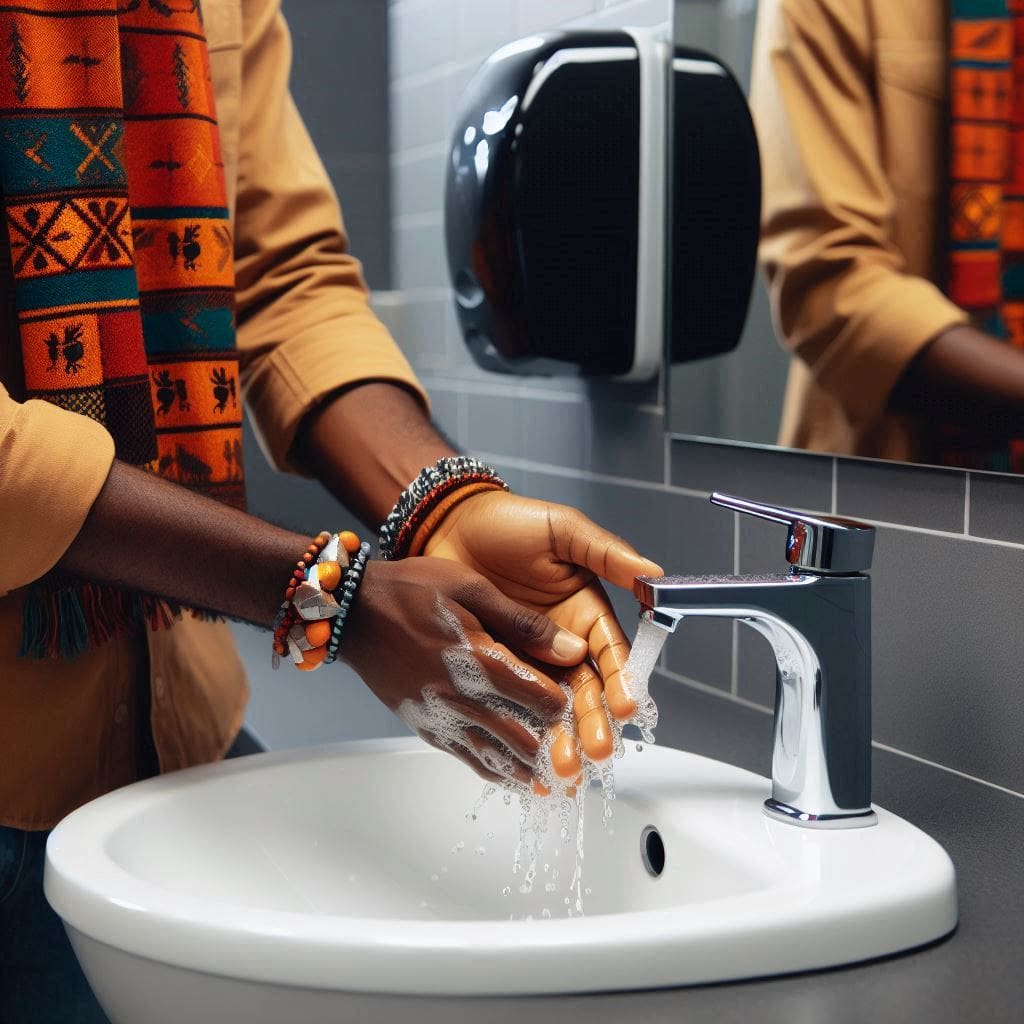Introduction

Even though it might seem ordinary, this small action is actually very important in stopping germs and many illnesses from spreading.
Why Handwashing is so important?
Our hands come into contact with countless surfaces throughout the day. From doorknobs and elevator buttons to shopping carts and handrails, these everyday objects harbor a hidden world of germs – microscopic organisms like bacteria, viruses, and fungi.
While some germs are harmless, others can cause a variety of illnesses, ranging from the common cold to more serious conditions.
These germs can spread from person to person in several ways. One common method is through direct contact, such as shaking hands with someone who is sick.
Germs can also linger on surfaces for extended periods. When you touch a contaminated surface and then your face, eyes, or nose, you unwittingly transfer those germs to your body, where they can invade and cause infection.
Ways that Handwashing protects you
Handwashing with soap and water is the single most effective way to stop the spread of germs and prevent infections. Soap acts like a magnet, attracting dirt, grease, and germs from your hands.
The friction created by rubbing your hands together helps loosen and remove these impurities, while rinsing with water washes them away.
Here’s how handwashing disarms germs:
- Disrupts the Germ Membrane: Soap molecules disrupt the outer membrane of bacteria and viruses, essentially dissolving their protective shell and rendering them inactive.
- Lifts and Removes Germs: The soapy lather helps lift and remove germs from the surface of your skin, preventing them from clinging on.
- Rinsing Away the Threat: By rinsing your hands thoroughly with clean water, you effectively wash away the loosened germs, preventing them from spreading further.
Diseases Prevented by Handwashing
Regular handwashing is a simple yet potent defense against a wide range of illnesses. Here are some of the most common diseases you can prevent by making handwashing a habit:
- The Common Cold and Flu: These respiratory illnesses are highly contagious and spread through contact with infected droplets. Proper handwashing significantly reduces the risk of getting sick and spreading these viruses to others.
- Diarrhea: This unpleasant condition is often caused by ingesting germs through contaminated food or water. Handwashing before eating and after using the restroom is crucial for preventing diarrhea.
- Foodborne Illnesses: Bacteria like E. coli and Salmonella can contaminate food during preparation or storage. Washing your hands before handling food and after touching raw meat helps prevent these illnesses.
- Skin Infections: Germs can easily enter the body through cuts or abrasions on the skin. Regular handwashing helps prevent skin infections like impetigo and cellulitis.
- Serious Infections: In healthcare settings, proper hand hygiene is vital to prevent the spread of infections to patients who may be immunocompromised. Consistent handwashing protects both healthcare workers and patients.
Effective Handwashing Techniques
While washing your hands with soap and water seems straightforward, there’s a right and wrong way to do it. Here’s how to ensure your handwashing technique is effective:
- Wet your hands with clean, running water (warm or cold)
- Apply enough soap to create a lather
- Rub your hands together vigorously for at least 20 seconds, making sure to clean all surfaces, including your palms, backs of hands, between fingers, fingertips, and under your nails.
- Rinse your hands thoroughly under clean, running water
- Dry your hands completely with a clean paper towel or hand dryer
Tips for Making Handwashing a Daily Practice
Here are some practical tips to help you make handwashing a regular habit:
- Keep soap and hand sanitizer readily available at sinks in your home, workplace, and car.
- Wash your hands after using the restroom, blowing your nose, coughing, or sneezing.
- Wash your hands before and after preparing food, eating, and feeding children.
- Wash your hands after touching animals, including pets.
- Wash your hands after touching garbage.
- Wash your hands before putting in and taking out contact lenses.
- Wash your hands before and after cleaning wounds.
The Importance of Teaching Handwashing to Children
Instilling good handwashing habits in children from a young age is crucial for their health and well-being. Here’s why:
- Children are more susceptible to germs: Their developing immune systems make them more vulnerable to infections.
- Frequent contact: Children explore the world through touch, coming into contact with various surfaces and objects harboring germs.
- Poor hand-eye coordination: Younger children may struggle to wash their hands thoroughly, making proper technique essential.

Strategies for Teaching Handwashing to Children:
- Make it Fun: Use brightly colored soap, sing a song for 20 seconds while washing, or create a handwashing game.
- Lead by Example: Children often learn best by observing their parents. Make handwashing a routine you do together.
- Explain the Why: In simple terms, explain how germs can make them sick and how washing hands helps keep them healthy.
- Provide Visual Aids: Use posters or pictures demonstrating proper handwashing technique.
- Practice Makes Perfect: Supervise and guide young children as they wash their hands, ensuring they reach all areas.
Handwashing When Soap and Water Aren’t Available
While soap and water are the gold standard for handwashing, there are situations where they might not be readily available. Here are some alternatives:
- Alcohol-based hand sanitizers: Choose a sanitizer with at least 60% alcohol content. Apply a sufficient amount to cover your hands and rub them together until dry. Be aware that sanitizers may not be effective against all germs, and they don’t remove dirt and grease.
- Sanitizing Wipes: These can be convenient for on-the-go cleaning, but they have limitations similar to sanitizers and may not be as effective as soap and water.
Additional Benefits of Handwashing
Beyond preventing illness, handwashing offers some additional benefits:
- Reduced Absenteeism: Proper hand hygiene can help students and employees stay healthy and reduce absenteeism in schools and workplaces.
- Improved Overall Health: By preventing infections, handwashing contributes to overall better health and well-being.
- Cost-Effectiveness: Regular handwashing is a simple and inexpensive way to prevent costly medical bills associated with illnesses.
The Power of a Simple Act
Washing your hand with soap and water is a simple but undeniably powerful tool for safeguarding your health and the health of those around you. Making a habit of washing your hands every day can help you lower your chances of getting sick.
Remember, washing your hands isn’t just about getting rid of dirt; it’s about staying healthy. By washing your hands regularly, you’re taking care of yourself and those around you.
So, let’s make handwashing a top priority and tell others how important it is for keeping everyone healthy.



